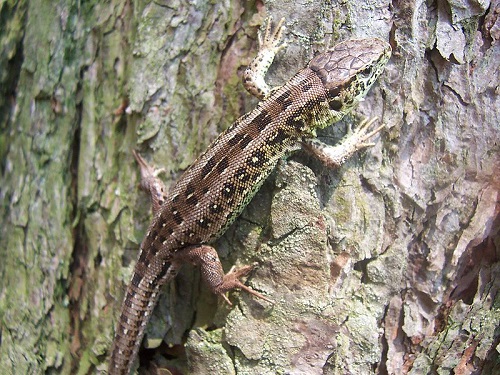

Lézard Agile Lacerta agilis Sand Lizard
(Syn. Française : Lézard des Souches)
Sand lizards, which can measure 20 centimetres, have stocky cylindrical bodies with short legs, short wide heads, rounded noses and short tails. The background colour of females is pale grey to light brown, with a creamy white belly and a pattern of brown spots or blotches running along the back and sides. The markings are often filled with a white spot or dash, tones of green are normally completely absent in females. Males normally have green backs and sides with a pale green belly; these colours are enhanced during the breeding season, a series of brown or darker marks forming a band run along the centre of the back, bordered by two lighter lines.

The area of distribution for this species in France is concentrated in a broad band which runs from the borders with Germany, down through an arc to the Mediterranean coast, isolated sightings are sometimes made outside of this zone. Habitat is generally rich in vegetation, bushes and trees or grasslands, also to be found in sand dunes. In all of these localities, outside of the breeding season, they will often spend much of the day underground in cavities that have previously been made by other creatures. In spite of its French name, it isn’t particularly agile at all, spending most of its time on the ground and rarely climbing. Prey is mainly insects and hibernation starts early in September or October until March.
Reproduction, which takes place in May and June, is accompanied by spectacular fights between males which sometimes result in serious injuries, these combats start by way of a complex ritual and usually finish when one of the participants flees, leaving the victorious male with the female. Eggs, about 10 to 15, are deposited by the female deep in a hole or burrow that she makes, where they hatch 2 or 3 months later.
Populations have seen a severe decline across the entire natural range for this species, mainly as a result of habitat loss.
Fully protected species in France



